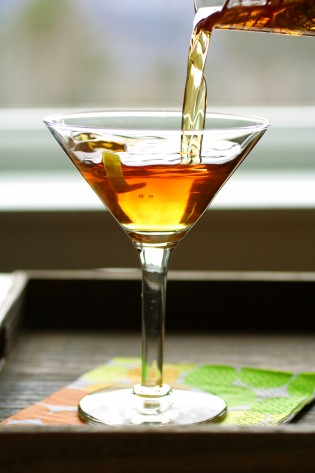Siamese Cocktail

Right now I’m waiting to hear from the publisher of the current DCCC pick about whether my request to post a few Thai food recipes on the DCCC blog will be granted. I don’t post recipes from cookbooks without receiving permission first, unless I’ve adapted a recipe considerably. And there has to be a good reason for me to change something; I won’t just change something for the sake of changing it so that I can say a recipe’s been adapted, thereby skirting the permission issue. If something is perfect as is, why touch it?
I’m especially hesitant to tinker with a recipe when the subject of a cookbook is a foreign cuisine, from a land I’ve never visited, and the cookbook is written by an expert, someone who’s spent years learning that cuisine and steeping themselves in the culture—in this case, chef and cookbook writer David Thompson.
But permission requests are one of the more tedious aspects of publishing. Drinking a cocktail is a lot more fun. So, while you’re waiting for the main course (hey, maybe you could supplicate Random House on my behalf, telling them to speedily process my request because you’re waiting for some delicious Thai recipes to appear on the blog.), I thought I’d offer you a cocktail.
If you’re familiar with the Sazerac Cocktail, one that would be on my top ten list of cocktails if stranded on a dessert island, and the licorice-laced flavor of Thai basil, you will immediately recognize the inspiration for the Siamese Cocktail.
Today the Sazerac is made most often with rye whiskey, but originally it was made with cognac, which happens to marry the flavor of Thai basil perfectly with the requisite Peychaud’s bitters. Why Thai basil? Traditionally, back when Absinthe was legal—long before its recent legalization and rebirth—the glass was rinsed with the anise-flavored liqueur, then, during the intervening dark years of banned absinthe, it was rinsed with an absinthe substitute, such as anise-flavored Herbsaint or licorice-flavored Pernod, before pouring in the remaining Sazerac ingredients: cognac/whiskey, simple syrup, and bitters. Here the anise/licorice dimension is introduced via the Thai basil–infused simple syrup.
If you enjoy this cocktail, check out the Jan/Feb, 2012, issue of Saveur magazine; there is story (with recipes) about cognac-based cocktails by David Wondrich.
Siamese Cocktail
3 ounces cognac
2 teaspoons Thai basil simple syrup (recipe follows)
4 to 5 drops Peychaud’s bitters
1 lemon twist, for garnish
Combine the cognac, simple syrup, and bitters in an ice-filled mixing glass. Stir for 20 to 30 seconds and strain into a chilled cocktail glass. Twist the lemon twist over the cocktail to release aromatic oils, then rub it, peel side down, around the rim of the glass, and drop in.
Thai Basil Simple Syrup
This is a 2:1 simple syrup. The extra sugar not only creates a sweeter syrup and more luxurious texture, but also works, along with a touch of vodka, as a preservative. This is how I like to make simple syrup when infusing it with herbs, ginger, or any other fresh ingredients. (I got the idea of using vodka from David Wondrich’s book Imbibe!. In his recipe, he also gives the option of using grain alcohol; if using, use half the amount of vodka.) This quantity makes more than you need for the Siamese Cocktail, but it lasts a very long time—up to a year—and can be used for other purposes. Try it, for example, in soda water with a squeeze of fresh lime.
Makes about 1¾ cups
1 small bunch Thai basil (about 1 ounce)
1½ cups sugar
¾ cup water
¼ ounce vodka
Cut the Thai basil bunch in half or in thirds so that it will fit easily in the bottom of a saucepan and be mostly submerged in the sugar and water. Combine the sugar, water, and basil (leaves and stems) in a saucepan. Place over medium heat and stir frequently until the sugar dissolves and the Thai basil wilts. Let the syrup come to a simmer, then remove from the heat and let cool completely, about 30 minutes.
Using a fine-mesh sieve, strain the syrup, pressing against the basil to extract any liquid. Double strain—using two fine-mesh sieves at once—into a clean glass jar, stir in the vodka, seal, and store in the refrigerator.
